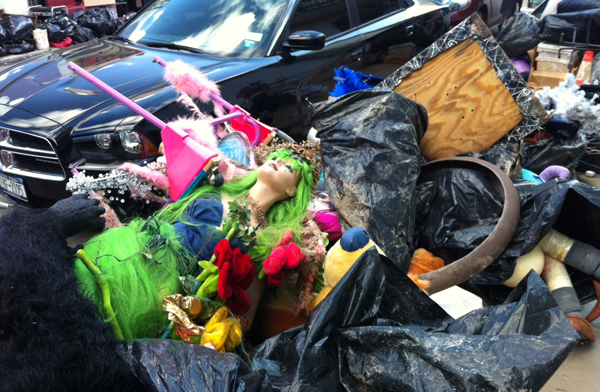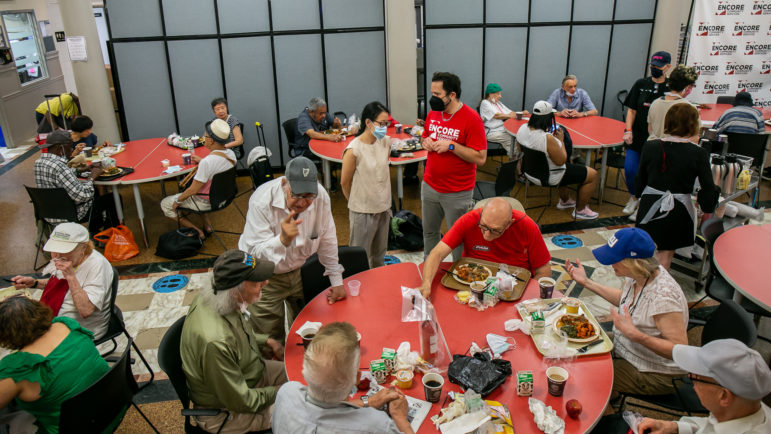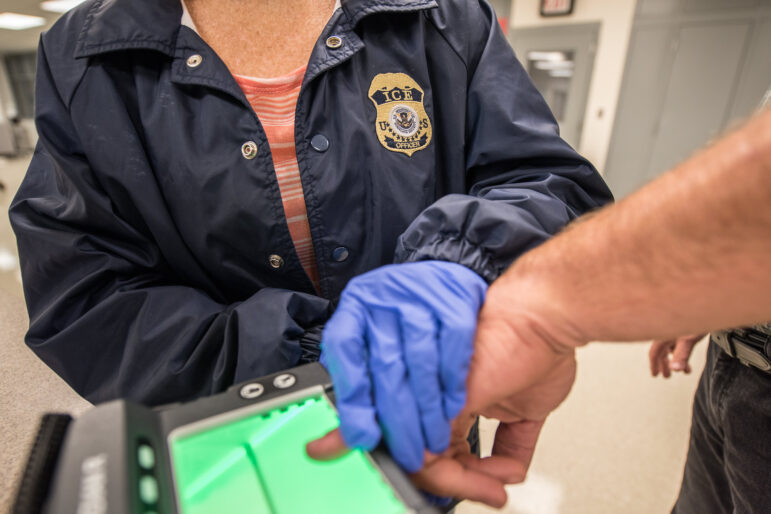
Photo by: Helen Zelon
On a bright Sunday morning, Brighton Beach is all action and bustle: Piles of sodden carpet and dry-wall line the streets, with random crutches, mannequins (like the one at left), furniture and other detritus, as residents shovel what seem to be acres of sand from their sidewalks and shopfronts. The sand is ankle-deep on the busy street, and banked up higher in apartment-building breezeways and carports. One longtime local found in the sand that filled her front yard a horseshoe crab– and said that the boulders that for decades separated her block from the ocean were lifted up onto the street by the waves. Still, she says,”we’re ok, we’re fine,” and goes back to sweeping up.
An elderly Russian couple walk arm in arm on Brighton 1st street, snapping pictures of sandbanks taller than their shoulders. “Talk very slowly,” he says, as his wife takes photos. They live on Brighton 6th Street, he explains, in the small thicket of blocks along the neighborhood’s commercial thoroughfare, Brighton Beach Boulevard, and between Coney Island Avenue and Ocean Parkway. Their large apartment building took on some water, which the super pumped out – but still, they were without electricity and gas for four days, and the water they have now is cold. “They were big waves, very scary,” says the Mrs. “The current was rushing very fast.” Half in pantomime, she shows how they take sponge baths with water heated on the stove.”Don’t worry,” she says, laughing.”We can wash.”
On a bright Sunday morning, Brighton Beach is all action and bustle: Piles of sodden carpet and dry-wall line the streets, with random crutches, mannequins, furniture and other detritus, as residents shovel what seem to be acres of sand from their sidewalks and shopfronts. The sand is ankle-deep on the busy street, and banked up higher in apartment-building breezeways and carports. One longtime local found in the sand that filled her front yard a horseshoe crab– and said that the boulders that for decades separated her block from the ocean were lifted up onto the street by the waves. Still, she says,”we’re ok, we’re fine,” and goes back to sweeping up.
Routine and emergency, side by side
Smells are everywhere: the smell of rot mixes with the scent of curry powder; the spoiled-egg smell of sulfur mingles with the wafting perfume of fresh-baked, cherry-filled pastries. Generators throb on nearly every block, pumping out basements even as merchants hawk”damadge”d goods. And on the block where Ocean Parkway meets the boardwalk, a Bobcat with a front-loader makes steady laps, scooping giant shovelfuls of sand from a multilevel parking garage – where the unfortunate cars parked on the lowest level are now walled in by sand and ruined by seawater, and where parking attendant Jacques Galan was sitting in his tiny blue booth as the storm made land, last Monday.
See footage of Sandy’s arrival in Brooklyn, shot by Coney Island History Project Director Charles Denson
“I was sitting in the booth,” he told the Brooklyn Bureau,”when the super called, and said, get out, get out! I had no idea, I don’t know anything. But then, I saw the water coming – this way, and this way, and this way,” gesturing in a 270-degree swath.”I was running,” he recalled, but the going was hard, because the water soon swelled to hip height. It eventually rose to more than five feet. Jacques’ car is ruined, too, standing outside on the street, as are dozens of others, set helter-skelter and crusted in a custom coat of sand and sea grit.
Up on the Boardwalk, though, it’s an autumn Sunday: Couples stroll the wide faux-wood expanse, which – unlike Coney’s wooden boardwalk – survived, intact. Dogs togged out in Crayola-bright coats walk their owners in the bright November sun, and sunbathers fill the benches, taking in the warmth. The only sign that something is different is the crowd at the boardwalk cafes: Instead of locals sipping coffee, cleanup crews sit at the outside tables, taking a midmorning break.
Precautions paid off
Jan Dykstra has lived in Brighton Beach for 22 years; like many others, he discounted the city’s hurricane warnings after Irene and stayed home. “Everyone was in the building,” he said, of his neighbors in a nearby high-rise, defying evacuation orders. But he did take the precaution to move his car, to the third level of the parking structure at inland mall Kings Plaza. “I did it for Irene, too,” he said, and now, his car is safe – and functional.
Dykstra said he filled his tub, sink, and pots and pans with water and hunkered down to wait for the storm. He lost power early in the evening, but felt certain that he and his family would be better off in their 6th floor apartment than anywhere else. The building’s ground floor filled with water, Dykstra said, which drained away overnight – leaving his lobby, like so many others, with waterlogged carpeting (since pulled out) and sodden drywall (to be replaced). And the building’s parking garage? Like others nearby, the cars at sea level were submerged in saltwater, totaled.
“I had no power, no internet, no cell,” Dykstra said.”I stayed in the dark – I had one little flashlight, and my wife had the big Max Lite.” Power was restored on Wednesday, but the building’s elevator was still non-functional, because the salt-soaked mechanicals, in the building’s basement, needed repair. By Sunday, Dykstra had his TV and Internet service restored – and zero regrets about not leaving his home during Sandy.
Free food and ‘free-market’ coexist
A playground near the boardwalk was crowded with children – and with what appeared to be a greatly expanded sand pit. Players nearby bickered over chess games and hustled pickup basketball. A NYPD school safety officer stopped on the boardwalk to look out at the ocean. Based in the Bronx, he said his unit was handing out food in Coney Island that day. He’s been working 16-hour days since Sandy struck, he said, and the sun felt good.
At the foot of Coney Island Avenue, near the Shorefront Y, a ring of military Humvees demarcated a food distribution site, where more than 100 bundled-up locals stood in line, chatting and waiting for supplies: cases of military rations and flats of bottled water were stacked up tall, ahead of the 3 p.m. distribution time. A National Guardsman passed out water to some elderly folks sitting on the Boardwalk. Stationed in Buffalo, he had been in Rockaway on Friday, on Beach 25th Street. Saturday was tough; he was posted to Breezy Point.”We were still pulling bodies outta there yesterday,” he said, so food distribution on a quiet Sunday in Brighton was”much better duty.”
Lauren Gorelova, a seventh-grader at PS 209, stood in the line with her grandfather, translating questions and her grandfather’s answers. She lives in Coney Island, she said, but her mother has a house in Brighton, which flooded. At home, Lauren said she had power – computer, TV, lights. She wasn’t sure exactly why they were standing in line; her grandfather explained, through her, that he had power as well. (He lives on the 15th floor of a high-rise on the next block.) But, she said, they saw the line, and got in, evoking a trope familiar to anyone – anyone – who lived under Soviet rule, as her grandfather did before his immigration. If there’s a line, there must be a reason – so you join. “All good, everything good,” grandpa said –”everything, good.”
The walls of wet garbage that line Brighton Beach Blvd didn’t deter shoppers, who plied the busy blocks with shopping carts, strollers and bundles of laundry. (The Laundromat is the busiest storefront on the avenue, standing room only, with long waits for machines.) A man wheeled a child’s bike from a garbage pile; nobody blinked. The ‘train arriving’ bell from the elevated train station chimed incessantly – but of course, no train is coming, not yet.
The bustle of commercial life dominates: a woman sells pastries on the sidewalk at Brighton 5th Street, the fruit stand and fancy-food shops are filled with delicacies, and nightclub/banquet hall Primorski is ready to receive dinner guests, unfazed, even though a hose snakes from its basement, pumping water to the gutter. A flood sale is mobbed – designer shoes, coats, perfumes. Capitalism and sheer enthusiasm seem to have survived Sandy unscathed in this beachfront enclave, with a life-affirming vengeance.








